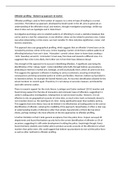Offender profiling – Bottom-up approach 16 marker
Offender profiling is used to limit number of suspects to a crime in hope of leading to a correct
conviction. The bottom-up approach, developed by David Canter in the UK, aims to generate an
understanding of the offenders visual, and motives, through investigative psychology. Unlike top
down it does not use typologies and is ‘data driven’.
Investigative psychology aims to establish patterns of offending to create a statistical database that
can be used as a tool for comparison, to see whether crimes can be related to previous ones. Canter
says when interpreting a crime scene, we must consider it’s time and place significance, career, and
forensic awareness.
This approach also uses geographical profiling, which suggests that an offender’s home base can be
revealed by previous crimes in the area. (crime mapping). Canters circle theory outlines patterns of
offending behaviour from one’s base. ‘Marauders’ commit crimes closer to home base creating a
‘circle’ boundary around it, ‘commuters’ travel away from base and towards a different area. It is
suggested that crime is less likely, the further one is from their base (distance decay).
One strength of this approach is its success in identifying offenders. A significant case being the
identification of the ‘railway rapist’, Canter identified John Duffy through bottom-up procedures,
predicting an interest in martial arts, bondage, as well as physically short, which all came to be true.
This suggests the approach is effective in leading to correct convictions, ensuring criminals face
consequences and bring somewhat justice to victims and families. However, bottom-up has failed in
its intentions before, for example the Rachell Nickels case. An incorrect identification allowed for the
actual murderer to commit again. Therefore, it is not always an accurate measure, and should be
used with extreme caution.
There is research support for the circle theory. Lundrigan and Canter analysed 120 US murders and
found strong support for the idea of marauders and commuter types of offenders, suggesting it is
useful in aiding police investigations, helping them to narrow down locality. However, it is not
effective to rely on geographical accounts of crime data, as much crime (such as domestic abuse) is
not recorded, known as ‘the dark figure of crime’, being significantly larger than statistics portray.
This suggests that circle theory may not be limited in its effectiveness at leading police to the correct
identification of offender, reducing the credibility of the approach. Nevertheless, it offers a clear way
of understanding locality of offenders rather than simply characteristics of them like top-down
shows, perhaps making it the more effective of the two approaches to offender profiling.
A further limitation is that it lacks general acceptance from the police force. Copson surveyed 48
departments and found that bottom up only led to the correct identification of offender on 3% of
occasions, suggesting it is still under development in aiding the police. Surprisingly though, Koscis
found chemistry students were better able to produce accurate accounts of the offenders to solved
murders than police were, this could suggest that bottom-up procedures do not suit the police force
as well as other methods to offender profiling.





